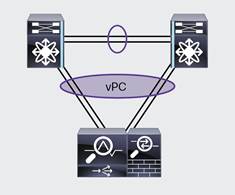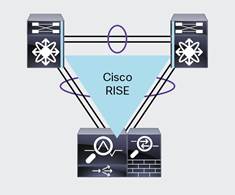Cisco Remote Integrated Services Engine
Available Languages
Product Overview
The Cisco® Remote Integrated Services Engine (RISE) is an innovative solution that allows any service appliance, whether physical or virtual, to appear as a virtual line card on the Cisco Nexus® 7000 Series Switches: in particular, on the Cisco Nexus 7700 platform. Cisco RISE establishes a communication path between the network data plane and the service appliance. This tight integration simplifies service deployment and optimizes application data paths, resulting in increased operation efficiency in the data center (Figure 1).

With Cisco RISE, physical and virtual service appliances can be directly attached to a pair of Cisco Nexus 7000 Series Switches running virtual PortChannel (vPC) technology (Figure 2). Appliances can also be attached indirectly through any Layer 2 network (Figure 3). Either way, service appliances attached to Cisco Nexus 7000 Series Switches achieve sufficient device and data-path redundancy for fault tolerance.


Main Benefits
The main benefits of Cisco RISE include the following:
● Enhanced appliance availability: Cisco RISE enables efficient management of the service appliance by obtaining real-time route updates from the service appliance, thereby reducing the likelihood of dropped routes for application traffic. By taking advantage of the extended control plane, Cisco RISE can provide faster convergence and recovery from service failures at both the application and device levels. Cisco RISE also enhances the day-0 experience through autodiscovery and bootstrapping, reducing the need for administrator involvement.
● Data-path optimization: Administrators can use a broad range of Cisco RISE capabilities to automate and optimize delivery of network services in a dynamic data center. In application delivery controllers (ADCs), automated policy-based routing (APBR) enables the appliance to obtain the Cisco Nexus switch parameters it needs to automatically implement the routes. These routes are learned dynamically whenever new applications are provisioned. APBR eliminates the need for administrators to manually configure policy-based routes to redirect server response traffic to the ADC while preserving the client’s source IP address.
● Cisco RISE also enables control-plane integration with Cisco Prime™ Network Analysis Module (NAM) 2300 platform appliances, simplifying the operating experience for network administrators. Integrated with Cisco Nexus 7000 Series Switches, Cisco Prime NAM delivers application visibility, performance analytics, and deeper network intelligence. This visibility empowers the administrator to effectively manage delivery of distributed applications. Cisco RISE integration will evolve to extend visibility transparently across multiple virtual device contexts (VDCs) on the switch, further improving operation agility and simplicity. Scalability and flexibility: Cisco RISE can be deployed across Cisco Nexus 7000 Series Switches and allows service appliances to run in VDCs, thereby allowing independent service instances to be deployed in a variety of ways such as one-to-many, many-to-one, and a countless variety of many-to-many configurations to support any multitenant scenario.
● Increased business agility: Cisco RISE can adapt to growing data center and customer demands by provisioning resources in real time. Cisco RISE also reduces the time needed to roll out new services, eliminating the need to redesign the network, and responds dynamically to changing customer requirements.
Main Features
● Simplified provisioning: Cisco RISE technology reduces the number of steps required to provision service appliances. By centralizing PortChannel configuration, Cisco RISE eliminates the risk of errors due to misconfiguration. In addition, service appliance management information is pushed from the Cisco Nexus 7000 Series Switches to the service appliance so that upon initial power-up, the service appliance’s GUI can be reached without any preconfiguration on the service appliance itself. This simplified provisioning process not only simplifies the out-of-the-box experience, but also allows the user to preprovision future services, so that when these services are added, they simply need to be racked and powered on, with no changes to the Cisco Nexus switch Auto-policy based routing: With APBR, the ADC dynamically communicates the services to the Cisco Nexus 7000 Series Switches as the services are provisioned. Cisco RISE then provisions the policy-based routes to redirect server response traffic to the ADC while preserving the client’s identity by preserving the client’s source IP address. By eliminating the need to manually configure policy-based routing to correspond with the real-time network changes in a data center, Cisco RISE simplifies application scalability and management.
Software Requirements
Cisco RISE is supported on all Cisco Nexus 7000 Series Switches and is available on Cisco NX-OS Software Release 6.2(8).
Ordering Information
Cisco RISE is supported in Cisco NX-OS Software Release 6.2(8) and requires the Enhanced Layer 2 Package license (Cisco part number L-N7K-EL21K9=).
For More Information
For more information about Cisco RISE, visit http://www.cisco.com/go/rise, contact your local account representative, or email the Cisco RISE product marketing group at rise-info@cisco.com.
 Feedback
Feedback